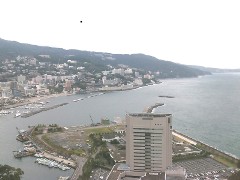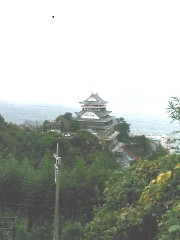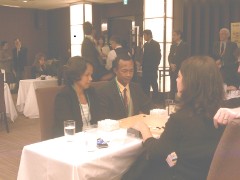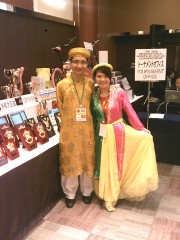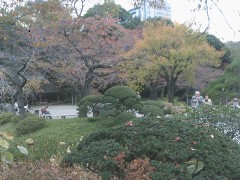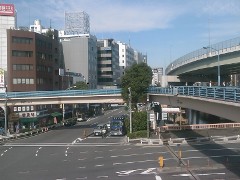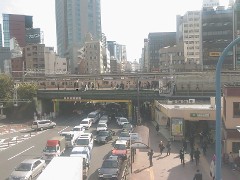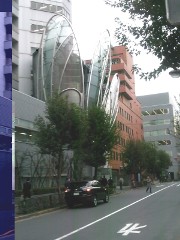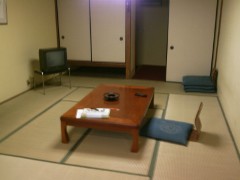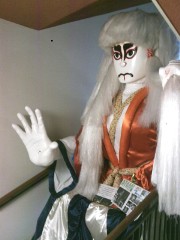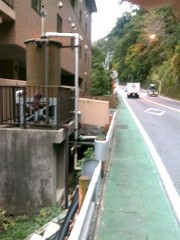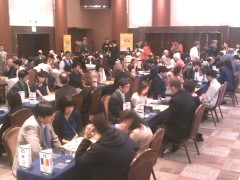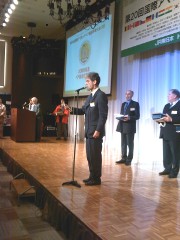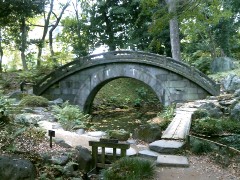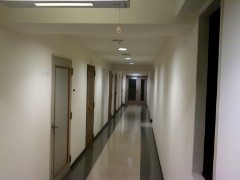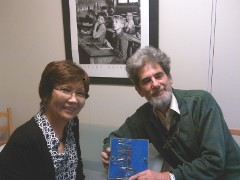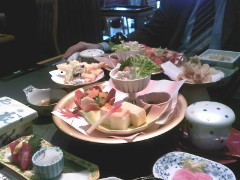| Navigation |
|---|
| Home |
| Christmas newsletter |
| Site index |
| Start again |
| ||
| ||
| ||
| ||
| ||
| ||
| ||
|
In mid-October I received an unexpected email from the Japan Pair Go Association. Would I like to attend the 20th Anniversary International Pair Go Tournament from 13th-17th November in Tokyo, to receive an honorary award for my efforts in promoting pair go in Britain? All I've done is to run the tournament for the last seven years, but you don't turn down an expenses-paid trip to Japan. So I rearranged a few commitments in London, and booked my flights. Here is a Japan diary.
Monday 9th - Tuesday 10th
Panic at Heathrow Terminal 3. The fire alarm goes off. I dutifully obey the instructions, and head for an emergency exit at the end of a long corridor; and then notice that I am almost alone. Those in the know have hung about just outside the central concourse. We are soon back in. Probably an unattended bag.
13 hours in the JAL plane to Narita Airport, where I find I can book train tickets in the terminal. Matthew Macfadyen and Kirsty Healey are the BGA’s competitors in the tournament this year, and they have decided to spend a few days beforehand at the seaside resort of Atami, on the Izu peninsula. I have decided to join them, but in my jetlagged state make a mess of booking trains, and end up at Tokyo station waiting an hour for an express, when an earlier stopping train would have got there sooner.
It is raining heavily at Atami, so taxi to the Aiola Hotel where I find that I have a Japanese style room with tatami mats, etc. And little actual furniture. Atami is a spa town with hot springs, and the hotel has an onsen or hot pool. This turns out to be the only place where you can get a shower, so I observe the Japanese custom of showering and then plunging naked into the rather hot water.
Wednesday 11th
I have learnt a little Japanese, and you certainly need it here in Atami. In Tokyo I sometimes got answered in English, but here it was gratifying to find that people preferred my elementary Japanese to their elementary English.
I had intended to make contact with Matthew and Kirsty. What I hadn’t expected was for them simply to walk into the hotel restaurant where I was enjoying a substantial Japanese breakfast. Out of the many hotels in Atami they had selected the same one. The rain was still heavy, so they practised their pair go against me all the morning. When it eased up in the afternoon we were able to go for stroll down to the harbour.
Atami is nothing like a British seaside resort. No Victorian waterfront architecture here; like most of Japan, it’s concrete blocks. But it is a pleasant enough place. Matthew draws our attention to Brown Eared Bulbuls and similar ornithological items, as is his wont. (I couldn’t honestly see what colour their ears were.) But soon the rain returns, and so back to the hotel for more go. Later we get very wet searching for a suitable restaurant.
Thursday 12th
The weather has eased, and we decide to go for a walk up the hill to Atami Castle. Kirsty spots a narrow path through the woods. I think it looks unpromising, but it does indeed bring us out above the castle. We have lunch there, and admire the sea views and the autumn colours. We return down a road which tunnels through the hill. I notice a bit of Victorian-looking engineering outside a hotel, with pipes and a tank issuing steam. It turns out to be the apparatus with which they heat their onsens geothermally.
Friday 13th
Time to return to Tokyo, on a sensible train this time. Tokyo station is the stuff of nightmares, with trains coming in on at least four levels over- and underground and from all points of the compass. There are three types of urban trains, and the tickets are not interchangeable; you’d better know which type you want. We make it to the Hotel Edmont at Iidabashi, and register our presence, and are duly welcomed by representatives of the Japan Pair Go Association.
There are plenty of old and new go friends here from around the world, so time passes quickly. Another British friend Tony Atkins is here now, having spent a few days using his Japan rail pass, in role as European Go Federation secretary. Edmont is a huge international-type hotel which probably has a quite a lot of stars. What it doesn’t have is public internet access, which was available when I was there in 2004 with my then pair-go partner Jackie Chai as competitors. Apparently that’s old-fashioned now; you get an ethernet cable in your room, and are meant to have brought your own laptop. I haven’t.
I am a poor sleeper at the best of times, but I don’t usually expect to be woken by my bed shaking. It was a small earthquake; apparently too small even to be mentioned on the news.
Saturday 14th
At 10.00 am we have a welcome ceremony, and then the first game in the five-round tournament is played. Honorary visitors like Tony and myself don’t have much to do now, but we are expected to be present, so we kibitz. At midday lunch bentos (boxes of Japanese food) are brought in, and then we are sent off to put on our National Costumes for the Friendship Game in the afternoon. Last time I was involved I put on my Morris dancing kit and did a dance for them; this time kit but no dance. Matthew and Kirsty dress as if for the Ascot races.
The Friendship Game involves pretty well everyone present. There is a draw for both partners and opponents. I draw a Japanese 8 kyu as my partner, and we find ourselves outclassed by a Japanese pair of dan strength. Next comes the Special Game; a game between two strong pairs with commentary.
In the evening comes a reception and the award ceremony, which seems to be the main reason why I have been flown out to Japan. There are to be seven Japanese and five overseas individuals to be honoured for their contribution to pair go development. I had previously been asked to make a short speech on behalf of the five overseas people. We are presented with our inscribed plaques (no, I haven’t translated mine yet, though it seems to have my name on it in written in kana characters,) and a ceramic clock. I make my speech, telling people what a good idea pair go is, and it seems to go down OK. There is a similar Japanese one on behalf of the seven Japanese honorands.
Sunday 15th
The Sunday is when the remaining four rounds of the tournament take place. There is also an open Pair Go tournament in adjoining rooms, with pairs from all over Japan, and some from overseas. This all lasts until mid-afternoon, and once again it seems that my main function is to kibitz. The final game between the two top ranked pairs is deliberately delayed so that we can all go and watch it progress on a demo board, with commentary by Michael Redmond 9P. Then we have, yes, another reception with the prizegiving ceremony. Kirsty and Matthew have come 19th overall, but they did win the prize for the best dressed pair.
Monday 16th
Not finished yet. Part of the proceedings is a presentation by Pandanet, one of the tournament’s sponsors. They run a go server, and would like everyone to use it instead of KGS or whatever. Not being an internet player myself this rather washes over my head. Then there is a final lunch, where we all sit round in a large square. Each country is invited to say something about the weekend, and Kirsty makes a suitably forceful contribution about how pair go has improved the atmosphere at British tournaments generally.
The afternoon is free, so Matthew, Kirsty and myself visit a local Japanese garden. Their gardens are one of the things which I most admire about the Japanese, and this one does not disappoint. In the evening M & K go off to an all-night go club; all right for youngsters.
Tuesday 17th
Time to leave Hotel Edmont, and decamp to nearby Weekly Mansion, where I have booked four nights through the internet. This is unlike any hotel I have previously visited. No servicing of rooms, no food available, no communal area, and no reception after 6 pm. What you do get is a rather more spacious room than at the mighty Edmont, and a small kitchen! It is more like renting a studio flat than a hotel room.
I return to Edmont where I have arranged to meet Mr Sekiguchi, a friend whom I have met at European Congresses, and visited twice before at his home in Yokohama. He takes me out for a rather early Japanese lunch, and the inevitable game of go. He has a another appointment, and I return to the Mansion for a much needed restful afternoon after the last few hectic days.
I tackle Japanese TV. My Japanese is nowhere near good enough to follow what is being said, but I am able to follow sumo, and would you believe curling, which like some other aspects of Scottish culture is popular in Japan. (Whisky’s another.)
Wednesday 18th
Like Edmont, the Mansion has no public internet access, so I ask for directions to a suitable café. This turns out to be Starbucks. “Dekinai”, (not possible) says the young waitress, using the plain form of the verb, instead of the polite “dekimasen” that I was taught to use. Apparently the polite forms are dying out amongst the younger generation of Japanese.
I still need to send some emails, so I hit on the idea of returning to Edmont and asking there. They direct me to a place one station stop away at Suidobashi. It is raining hard again, and the receptionist insists on lending me an umbrella, despite the fact that I am no longer a guest at the hotel. I walk past the internet café the first time. It is on the fifth floor of an anonymous looking building; no English in sight. Anyway, it works and is cheap.
Then on to meet Mr Ichikawa, another friend from European Congresses whom I visited last year. I find the correct part of Tokyo station, and he whisks me off to his go club, for games with him and his friends. One big change which I have noticed in Japan over recent years is the decline in public smoking; not a whiff of cigarette smoke. A most welcome improvement.
Later we all troop off to a Japanese style Italian restaurant, where he treats me to an enormous dinner. The style of service is more Chinese than anything, with seven small dishes served consecutively.
Thursday 19th
I thread my way through the Tokyo underground system to Senzoku, where my cousin Vernon runs a language school with his Japanese wife Yuri. Regrettably he is no go player, but takes me out for yet another Japanese repast. I am intrigued to find that he is not recession hit. Apparently the demand for English language and culture is resisting the downturn. They are busy preparing for Christmas, which the Japanese celebrate with commercial if not religious vigour.
In the evening I present myself at the Nihon Ki-in, hoping for some games in the main hall, which is open daily for amateur play. I arrive at 6 pm, thinking that the evening would be a peak period. It is not; there is hardly anyone left. I am charged half price, and they find me a young opponent to whom I give a seven stone handicap and beat three times.
Friday 20th
After some indifferent weather today is sunny, so I betake myself to the vast Ueno park. This is where Tokyo keeps many of its main museums, but I am in outdoor mood after all the rain, and in any case want to get back to the Ki-in at a more sensible time.
Which I do, at 2 pm. What is your grade, they ask. When I claim three-dan, they want to know if it is a KGS or Nihon Ki-in grade. Neither, I reply, it is a British Go Association grade. That is what I think I said, anyway. They promptly write me down as five-dan. They find opponents for you, at around the same grade. Playing at this inflated grade I win 3½/5 games. Whenever I leave Europe I start winning easily, and I do wonder who has got their amateur gradings right, Europe or The Rest Of The World.
Saturday 21st
Time to leave Weekly Mansion. I return to Ueno. I had found out the day before that luggage lockers were available, and that I could make them work. So my bag stays there, and this time after a good wander in the park, I decide to tackle a museum. I decide on Tokyo’s science museum. Not quite like ours in London; much smaller, for one thing. There are two buildings, for World Science and Japanese Science. And very different they are too. World Science is full of interactive this and that, in as many languages as you want. Japanese Science is all explained in Japanese. It was interesting to know just what science they had during their two centuries of isolation.
Time to start homeward. There is an airport train from Ueno, and surprisingly at Narita Airport station there is a baggage check. A shuttle bus takes me to the Edmont-like Excel Tokyu hotel. “When’s your flight tomorrow?”, they ask. For a 9.50 am flight they book me the shuttle at 7.20 am; a bit pessimistic, I think.
Sunday 22nd
And so it proves. Check-in is almost immediate, and I am left hanging around the departure area for two hours, awaiting my 13 hour flight to London.
This was my fourth visit to Japan. I have got to love the place, and I have many friends there, both Japanese and Western. And I have done my best to fly the flag for British go. Thank you, Japan Pair Go Association, for inviting me.
| ||
| ||
| ||
| ||
| ||
| ||
| ||
| ||
|
